— Had Wagner lived in the twentieth century, would he have turned to cinema to express his idea of the Gesamtkunstwerk?
This question is not new and is, of course, impossible to answer. It is comparable to wondering whether Giotto would have used CAD software to better project his feeling for perspective. In this case, however, such a question is not frivolous. Rather, it activates a long series of retrospective reflections on the heritage that Wagner left to cinematographers (see also: PARSIFAL ON TV: MET AND FESTSPIELHAUS).
Wagner, filmmaker
As opera audiences are nowadays composed more often than not of video spectators, the relationship between live performance and film opens a fertile ground for investigation. What is particularly interesting to investigate from this perspective is how the concept of Gesamtkunstwerk changes in the hands of different authors and directors. It is, indeed, only through a comparative analysis that the concept manifests its potentialities and its limits. Given the fact that Wagner’s ideas about a "total work of art" are tightly linked to a very specific Germanic imagery, it becomes necessary to study the reinterpretations other directors have made of those ideas in order to show how different systems of aesthetic values shaped and updated the original Wagnerian model. Researching and discussing the roots of Wagner’s Germanic imagery shows that the symbolic world driving it makes sense only if the spectator possesses the necessary knowledge and background to read and understand it. This paper will examine two filmed versions of Wagner’s Parsifal in order to illustrate how imagery and technology function in modern attempts to realize the Gesamtkunstwerk.
Cinema as a technical invention was not immediately connected to the creation of a better "total work of art". It needed to be upgraded from a mechanical tool for recording real life to an artistic expression in search of its own aesthetics. The Wagnerian operatic model, conceived just a few decades before the birth of cinema, could well provide the template for this aesthetics. As a synergetic union of the arts, it closely matched what cinema, as well, aimed to achieve from the very beginning of its history: the combination of multiple forms of expression (music, dance, words). In return, cinema could bring to Wagner’s Gesamtkunstwerk a greater flexibility in terms of time-space setting (editing), perspective (different shots and angles) and image/sound control (multi-track recording). While this flexibility had the potential to make cinema an independent art rather than a banal technical innovation without any aesthetics of its own, cinema was not initially understood in that way, or, at least, not as an independent art; the trend for experimentation would come later. Partly because of initial technical issues and partly because of a limited conception of moving images, cinema originally served as a kind of technologically advanced adjunct to theater and opera, giving them a degree of realism they supposedly lacked.
However, if colors and sounds are part of our daily experience of reality, why should a spectator at the beginning of the last century have deemed a black and white, silent, "dead" performance of Parsifal on a screen more realistic than a live performance of the same opera in the theater? Why is "live" less live than "dead"? Why, as a spectator at the beginning of the twentieth century, should I prefer a movie theater rather than a stage to watch the same story? An abundant specialized literature approaches these questions from ontological and psychoanalytical perspectives [2; 5; 15; 17; 20].
In the meantime, some immediate answers are that (1) to go to a movie theater was and is still cheaper than to go to the opera1; (2) to produce a movie is expensive but to reproduce it at the same time in multiple places and in a capitalistic system that allows considerable profits is far more convenient than multiple stagings of a theatrical work [3]; (3) as a spectator who lives in a small town, either in the 1910s or 2010s, I would have more opportunities to see an opera on the screen than on the stage.
1 For example, at the premiere of Faust at the Metropolitan House on 22 October 1883, a spectator would pay fifty dollars for a box holding six seats, six dollars for an orchestra stall, and three dollars for a balcony stall [16, p. 35]. In 1906, the price ticket for a seat at the projection of the Queen of the Convicts in the 14th St. Theater in New York ranged from 25 to 75 cents [23].
Given the previous observations regarding the audience’s experience of a silent movie in the 1900s, we could wonder how, for example, Wagner would have reacted to the filmic representation of his works at the beginning of the twentieth century. Considering the flamboyant, colorful, and highly spectacular productions of Wagner’s works in Bayreuth (as evinced by the commentaries and pictures from the last quarter of the nineteenth century), I doubt that the composer would have appreciated a black and white screening, silent or, at best, with a piano accompaniment of his or another’s music. Nevertheless, to invoke a futuristic model of the "total work of art" and to push our inquiry to the extreme, let us pretend for a moment that Wagner could have made use of the THX® surround system in a tri-dimensional IMAX® theater. The effect would be much more impressive than anything Wagner could have imagined in his time, at least in terms of immediate emotional and visual impact. As the above-mentioned technological apparatus subsists in a capitalistic system, would the composer be satisfied with the economy that supports such productions? Let us consider first that the socialist thinking of Wagner would probably not sit very well within modern capitalism; secondly, that his socialism was, however, elitist enough to push him to build his own theater for a select audience; thirdly, that for decades he and his family made Bayreuth the exclusive stage for Parsifal, thus preventing its circulation in a free market and limiting considerably the reproducibility of the work (even Schoenberg expressed his opinion on this point [26, p. 491-496]).2
2 Jeongwon Joe says: It is ironic that Parsifal, Ein Bühnenweihfestspiel [A Festival Play for the Consecration of the Stage], which Wagner sanctified by restricting its performance to his Festspielhaus, has been produced in a medium of film which can be shown anywhere at any time [13, p. 1].
Nonetheless, David Huckvale has attempted to downplay the sectarian aura of Wagner’s works by claiming that the primary longing of the composer was always an art for the people. Indeed, it took a popular movement, rooted in the techniques of mass-culture [National Socialism] to liberate Wagner from the cultural elitism of institutions such as Bayreuth [12, p. 141]. Incidentally, several pages of Huckvale’s article are dedicated to Wagnerian iconography and the influence that Wagner’s mythic world had on the twentieth-century way of interpreting reality.
"Art for the people" is the key expression that connects Wagner’s ethics to cinema’s politics, because cinema from the very beginning of its history has been addressed mainly to the masses. That cinema tried to follow the path forged by Wagner was on the one hand a logical step given its status as spectacle, but on the other a sheer mistake that remarkably delayed the development of cinema as an artistic expression endowed with its own language. The first mistake pioneers of cinema and critics committed was to think that Wagner had found the definitive formula for the union of the arts. Scott Paulin argues that collaboration, balance, and the interwoven function of the arts in the Gesamtkunstwerk never found a rest in the continuous refinement of the Wagnerian aesthetics, and the reason for this is that the whole concept was simply utopian: Simply put, it [Gesamtkunstwerk] was a goal, the route to which Wagner frequently redefined [25, p. 61]. One of the explanations Paulin gives to justify cinema’s interest in Wagner’s aesthetics illustrates a subliminal strategy: Just as in classic psychoanalytical terms the fetish object functions to disavow a lack or absence (to repress the "knowledge" of castration), the fetishization of "Wagner" — the supposed unifier of the arts in Musikdrama — works to repress knowledge of the constitutional lack of unity in film, the material heterogeneity of the cinematic apparatus [25, p. 59]. In other words, cinema made Wagner its own object of veneration because he represented the idea of the unity of the arts, a unity that cinema longed for but could not attain because of its constitution as a heterogeneous artistic expression.
A series of misunderstandings occurred once film critics based their opinions on faulty premises, such as the notion that the concept of the Gesamtkunstwerk could be uncritically applied to cinema. For example, it was commonly assumed that music should fit the emotions expressed in the movies in the same way as in Wagner’s operas (here considering the mainstream commercial production, not experimental and vanguard cinema. One striking example is how film composers adopted the leitmotiv technique for the soundtracks of many movies during Hollywood’s Golden Age in the 1930s). Let us notice that this subsidiary role for music is not what Wagner theorized, especially at the end of his career when music gained a position of dominance over the other arts in his thinking — unbalancing once again its delicate equilibrium with dance and poetry envisioned in Opera and Drama. Moreover, cue-sheet encyclopedias3, which tried to appropriately match music and image in silent film, were organized as a taxonomy of general emotions and situations taken out of a specific context, that is, out of the unique dramatic frameworks in and for which Wagner wrote his music. This made the hoped-for filmic Gesamtkunstwerk even less total than Wagner’s utopian one. At the same time, just as dance (gesture) and poetry (word) in cinema were still ancillary to theatrical manners, music was pushed farther away from its goal of equality with the other arts. The result was by far a fragmented "total work of art".
3 Cue-sheets "were lists of recommended music (cued to specific spots in a film) published in trade journals like the Edison Kinetogram" [1, p. 346].
Once it was realized that the unity of discontinuous elements drawn from irreducible semantic contexts (for example music and image) is hardly attainable, two options were left: to stress that discontinuity and thus destroy the illusion-effect on which a great part of cinema is founded, or to cheat the audience by masking that discontinuity with the technical tricks that the filmic medium offers. That is what Paulin means when he says: Critics in favor of a close sound/image relationship tend to valorize the "parallel" whereas those with a contrary viewpoint speak negatively of the same phenomenon in terms of "redundancy". In general, the latter terms in the above binaries [sound/image closeness vs. sound/image discrepancy] are privileged by critics who advocate an oppositional cinematic practice, seeing a pernicious ideological manifestation in the endeavor to construct an illusion of unity and wholeness in which the techniques of production have been made invisible [25, p. 71].
The singular capacity of dramatic arts to create an illusion of reality provoked in the last century a tangled (and still extant) debate concerning the social function of art. The aesthetics of parallelism, sometimes considered by left-leaning critics as a sign of complicity with dominant social forces, can be expanded to include the illusion of continuity in the image/sound relationship both on the screen and the stage. At the root of this continuity is the idea of "endless melody", which owes its success more to its poetic definition than to its actual functionality (provided that its functionality is to remove any possible gap in the operatic and narrative continuum). This is particularly true if this idea is connected to the intention of making music a device to suture the discontinuity in visual editing. It is my opinion that music tries, but in the end, cannot articulate human emotions as they are represented on the screen; it cannot manifest an internal cohesiveness and coherence and, at the same time, maintain a perpetual flowing with the intention of denying the fragmented nature of the filmic discourse. Moreover, what does continuity in music mean? Can music really sound continuous? How is continuity affected by cadences, phrase organization and any other element that participates in a specifically musical syntax, namely, the set of rules that control and fix the separate components in a logical and comprehensible discourse? Wagner did not compose according to a syntactical plan. But however much he disregarded it he did not entirely negate the existence of a syntax in his music, otherwise we would not be able to recognize it as music, to talk about it and to appreciate or critically disdain it. Wagner created an illusion of continuity in a semantic field (music) that is not continuous at all (I am not trying to turn this into a black and white issue. The "continuity" in Wagner is neither natural nor wholly illusory, but is created (or not) against the backdrop of an extremely complex set of perceptual expectations that vary, of course, with individual listeners).
The theme of continuity vs. discontinuity (or Gesamtkunstwerk vs. fragmentation) as well as other ideas expressed in this polemical introduction (e. g., the relationship between live performance and video; iconography as the reinterpretation of historical imagery) will be applied to the analysis of the two movies mentioned in the abstract.
The Gesamtkunstwerk is a very slippery concept; it belongs to the Platonic "world of ideas". Authors and directors who wanted to engage with Wagner’s legacy produced works that range from accurate realizations to totally opposite interpretations without ever finding and, sometimes, not even aiming to achieve what Wagner himself intended. More importantly, I question whether a "total work of art" is attainable at all. It is an ideal that modern aesthetics (for example, multimedia productions and video installations) has to cope with continuously because of the multiple sensorial stimuli that bombard the individual in ordinary life. However, for reasons that will become clear, it seems that a work’s closeness to the Wagnerian ideal is inversely proportional to the display of technical devices, a situation that suggests how technology, because of the surprising illusions it is able to create, tends to impose itself on the spectator’s attention, thus breaking the equilibrium with the other components of the "total work of art".
The iconographical aspects of the filmic Gesamtkunstwerk will be analyzed here in order to illustrate how the variation of a constructive element such as a character or bit of scenery interferes with the other components (acting, camera movements, editing, etc.) of a heterogeneous medium like cinema. At the same time, the process of updating the Wagnerian imagery clarifies what timeless resonance the model has had, unless the insertion of spurious components (see below the figure of "Lucifer" in Edison’s Parsifal) intervenes to disorient the viewer. The modification of primary elements such as storyline or music can seriously challenge the integrity of Wagner’s idea of the "total work of art". As a secondary constituent of the Gesamtkunstwerk, the iconography thus makes possible an analysis of the historical evolution of a subject (in this case Parsifal) without losing contact with the original archetype.
By examining two versions of Parsifal I will show that the scenographical portrayal of Parsifal’s environment is a matter of the author’s imagination and not of his or her ideological adherence to Wagnerian thinking. Regarding Edison’s Parsifal, I will suggest a philological reconstruction of the narrative and a few possible sources for iconographical comparison. With the Syberberg film, instead, I will present and critically discuss both the complex imagery displayed in the movie and the way in which directorial choices in terms of editing, camera movements, and acting reflect a personal conception of the Gesamtkunstwerk.
Edison’s Parsifal
The first filmic staging of Parsifal, and indeed the first movie made on an Arthurian subject, was a 17-minute, 1,975-foot Edison production dating from 1904 (the Library of Congress’s reference print I saw amounted to 1,930 feet)4. Its synopsis is summarized in the following list of scene titles: Parsifal Ascends the Throne, Ruins of a Magic Garden, Exterior of Klingsor’s Castle, Magic Garden, Interior of the Temple, Scene Outside the Temple, Return to Parsifal, and In the Woods.
4 The movie was directed by Edwin J. Porter (not be confused with the much more famous Edwin S. Porter of The Great Train Robbery, 1903). The names of Porter, Adelaide Fitz-Allen and Robert Whittier (two singers of the cast), as was the common practice in early cinema, do not appear in the credits.
The visual language of Edison’s film immediately strikes the viewer for several reasons. First of all, let us observe certain camera effects such as sudden substitutions of objects or characters, as they occurred in several of Méliès’s fantastic movies (to produce this effect, the shooting is stopped in order to take away the first object and restarted when the new object is framed). Two examples: (1) at foot 1,019, a character that I will name Lucifer makes Kundry disappear “magically”; (2) from foot 14 to 23, during the scene of the Elevation of the Sacred Grail, the grail appears and disappears in the background (to be precise, it appears in the center of Frame No. 6, the empty space between the column on the left and the rock on the right):
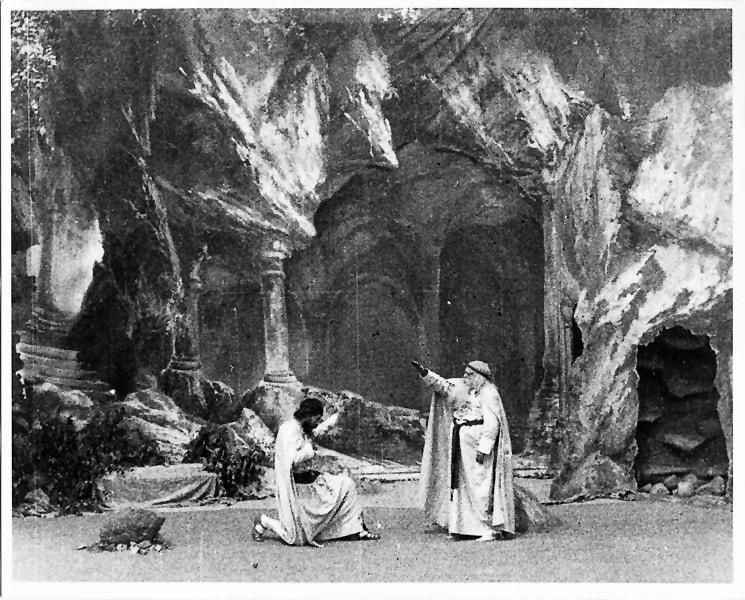
Frame No. 4
(All frames courtesy of the George Eastman House. The frames are numbered according to their chronological location in the film).
The former example, and other similar occurrences of object substitutions, is certainly a sheer camera trick; the latter, however, is more than a simple effect in that it implies some stylistic and narrative singularities typical of a nascent cinematographic language. Edison, probably for narrative clarity, stages all those antecedents to Parsifal’s vicissitudes that Wagner leaves out, thus leading to a better understanding of the drama. Furthermore, Edison curiously introduces the recurrent incarnation of the infernal power (the above-mentioned Lucifer), which makes the representation of Evil vs. Good far too obvious visually (but, again, the needs of intelligibility in the narratives of early silent movies could have suggested such a device). Thus, the first long scene of Edison’s Parsifal shows in order Lucifer, very arguably Titurel and Amfortas coming from the right, Kundry pursued by Lucifer coming from the back-left, mother with children (possibly Herzeleide and a young Parsifal) from the front-left, and, eventually, Lucifer and a man dressed in black (Klingsor?). Then, we see Amfortas with the Sacred Spear surrounded by the Flower Maidens and Kundry, who now wears a floral dress and flower crown that Lucifer gave to her. Kundry takes the spear and passes it to Klingsor, who wounds Amfortas as he stands in front of Herzeleide and the young Parsifal. A group of Knights rescues Amfortas.
The Elevation of the Grail appears at the very beginning, when Lucifer alone runs across the stage as if he is possessed by a macabre excitement for what he is planning to do. The concomitance of two scenes that evidently do not belong to the same spatial (and most likely temporal) location has both an ideological function (Evil and Good are posited as two different layers) and a complex narrative one: are we witnessing a prototype of parallel editing or a sort of primitive multi-screen projection, as in Gance’s Napoleon twenty years later? Whatever it is, this "camera trick" generates interesting interpretive possibilities.
Regarding the actors’ performances, the interpretation of Parsifal may seem coarse and amateurish, but the highly expressive style of acting is not surprising in itself. In a period in which acting in front of a camera did not demand a different approach from acting on the stage, actors’ gestures responded to theatrical modalities whose emphasis was correlated to the variable distance between the actor and the audience. In the coming years, close-ups and zooms would allow the last spectator in the stalls to appreciate every single detail of the acting and permitted the actor to cultivate an intimate and realistic performance. In 1904, Edison could not make use of such devices.
No matter how primitive were the linguistic and technical tools Edison could afford, he hoped to make his Parsifal a success by capitalizing on the triumph of the 1903 stage production of the opera in New York. But he incurred a lawsuit brought by the presumed owner of Parsifal’s copyright. As stated above, Wagner’s family secured the exclusive rights to perform Parsifal at Bayreuth until 1914, when the score began to circulate around the world. Parsifal was legally staged for the first time outside Germany at Covent Garden under Artur Bodanzky. According to Barry Millington, during the period of the embargo Parsifal was occasionally performed elsewhere: Ludwig the II had it put on privately in Munich in the years after Wagner’s death; it was seen by members of the Wagner Society in Amsterdam in 1905, and again in 1906 and 1908; and in the face of bitter hostility from Bayreuth it was mounted by the Metropolitan in 1903 under Alfred Hertz. [Other performances] were given in Europe… including two under Joseph Barnby in London in 1884 [19, p. 891].
Wagner’s family did everything it could to prevent the Met’s theatrical manager Heinrich Conried from staging the opera. When an informal appeal to the Kaiser produced no positive results, Cosima Wagner and her relatives sued Conried. The trial occurred in New York, but the court decided in favor of Conried because there was no copyright agreement between Germany and the United States. Nevertheless, Conried offered Cosima $20,000 which she disdainfully refused [For more information on the Metropolitan’s Parsifal see 10, p. 320-324; 14, p. 182-185]. It has been claimed that the owner of the copyright (Conried?) sued Edison and forced him to considerably cut the length of the movie to two reels only. This is doubtful since no copyright owner was nominated. It is certain, however, that the powerful Conried made every effort to protect the income that a timely issue of a filmed Parsifal in 1904 would have brought in. Indeed, the movie was finally released in 1907 and, due to difficulties with lighting in the theater, filmed outdoors, as the wind blowing against the backdrop clearly reveals. After a synopsis of the scenes, an advertisement in MPW (Moving Picture World) dated 7 December 1907 thus presented the film:
In Parsifal we offer the greatest religious subject that has been produced in motion picture since the Passion Play was first produced by the Edison Company about eight years ago, and there has been a constant demand for this picture during all these years, and continuing up to the present day. At the same time, there has been not only a demand, but a long-felt want for a new religious picture of interest and merit similar to the Passion Play.
In Parsifal we believe we have filled this want. A large amount of time, labor and money has been expended in producing this dramatic production used for taking these pictures, the company having played Parsifal for several seasons. The result is, that we have produced a picture both dramatically and photographically perfect, which we offer to our customers and the public with every confidence that it will be received accordingly.
With each [copy of the] film we furnish a complete, illustrated lecture, giving a historical sketch of the life of Wagner and his works, the story of Parsifal, and a synopsis of the different scenes. This lecture is a special feature. It is in itself a literary merit, and every exhibitor will find it of material assistance and value in connection with the picture. We also furnish a musical score for the piano when desired.
No. 6045. Code, Vaquant. Length, 1,975 feet. Special price, $335.75 [22].
Notice that whereas both the film and the lecture were included in a single package, the music was available only upon request, and it is not clear if an additional payment was due in order to receive the score. It is possible that the score provided by Edison Studios was a piano arrangement of Wagner’s music corresponding to those scenes from Parsifal selected for the movie. But what happened when a theater manager did not ask for the score? According to the economic resources of each theater, one of the following situations probably occurred: (1) the movie was screened without music at all; (2) a record with, possibly, Wagner’s music was played (perhaps synchronized)5 during the screening; (3) unrelated music was improvised by the pianist or organist; (4) the pianist prepared a collection of motives on which to improvise a fitting accompaniment to the images; (5) the pianist composed his own arrangement of Wagner’s music.
5 Experiments in record/film synchronization go back to the very beginning of cinema history. Susan Hayward writes that Gaumont had been working on a series of processes of synchronized sound since 1902 [11, p. 332-335].
The advertisement stresses the religious character of the movie but says nothing about the unsettling political and sexual aspects of the opera. By associating Parsifal and the Passion, the Edison Studios evidently tried to convince the previous Christian audience to attend the new production as if it were a Biblical story (hence the presence of Lucifer). Nevertheless, the synopsis does succeed in gathering all the crucial events of Parsifal’s saga. Even the most sensual scenes are present: the Magic Garden (as mentioned in the synopsis and pictured in Frame No. 4) and the titillating dialogue between Kundry and Parsifal (as evinced by Frame No. 5), including the kiss between the two:
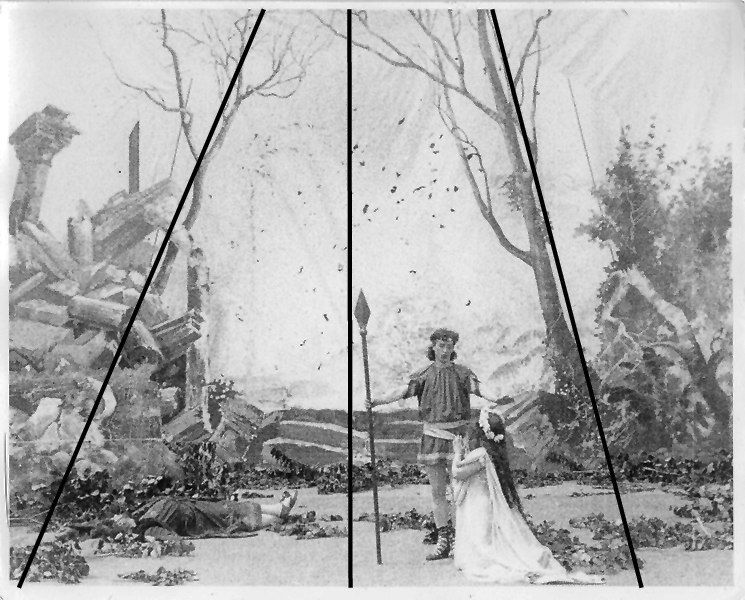
Frame No. 4
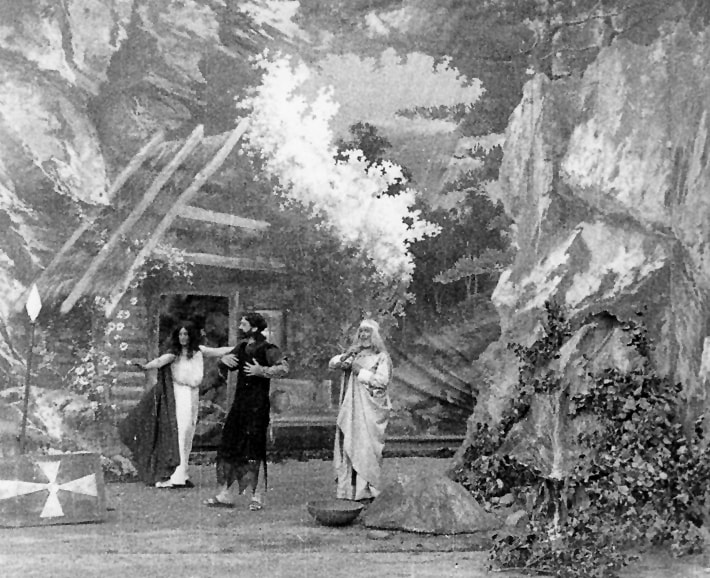
Frame No. 5
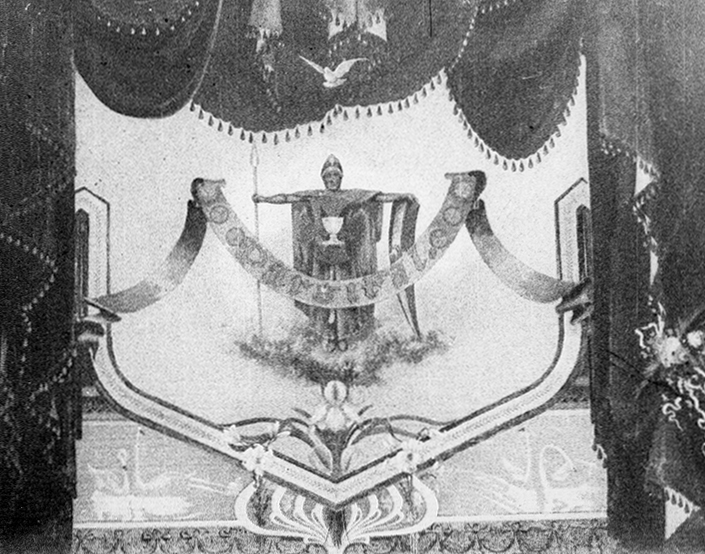
Frame No. 1
A close examination of a few frames will better contextualize the iconographical traits of Edison’s movie and tie its imagery to specific periods of art history in order to show how Edison both preserved and altered aspects integral to Wagner’s mythic scenario. Frame No. 1 represents the curtain of the theater. The main symbols of Parsifal are clearly drawn: the Grail, the Spear, and centered on the top, the Swan. Curved ornaments and flowers seem to refer to the Art Nouveau style, above all the decoration at the bottom from which three flowers emerge.
A similar, but far less geometric, scenario is shown in Frame No. 3: the luxurious vegetation corresponds to a hedonistic vision of the sinful world and the florid motif on the Flower Maidens’ costume makes them an integral part of the lush nature that surrounds an architecture of classical proportion in the background. Parsifal can barely be seen behind the bacchanal dance of the Maidens.
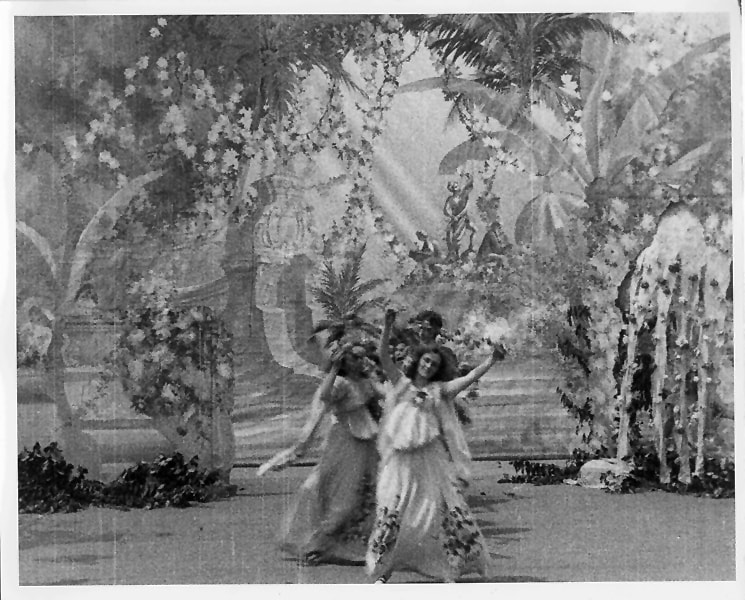
Frame No. 3
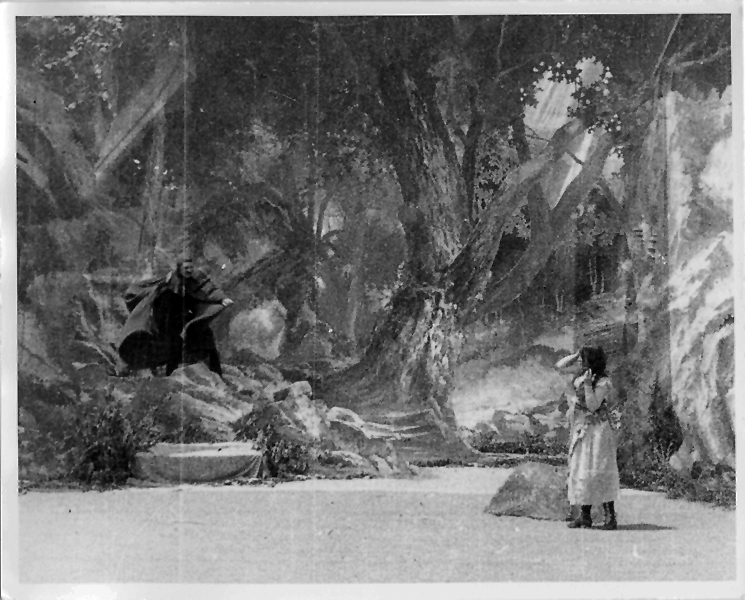
Frame No. 2
Frame No. 2 shows the beginning of Act II, where Lucifer harasses a weak Kundry in a patent state of inner distress. The surrounding natural scenery, as we will see in other frames, is purely romantic and contrasts remarkably with the dream-like Magic Garden, thus setting in opposition two different degrees of realism in a mythic world.
The scenery evokes a wild environment in which vegetation has grown up and blossomed out of human control. Compare, for example, The Pond (1850) by Théodore Rousseau (Fig. 1) and the Tree with Crows (1822) by Caspar David Friedrich (Fig. 2) with the tree that dominates the scene in the frame:
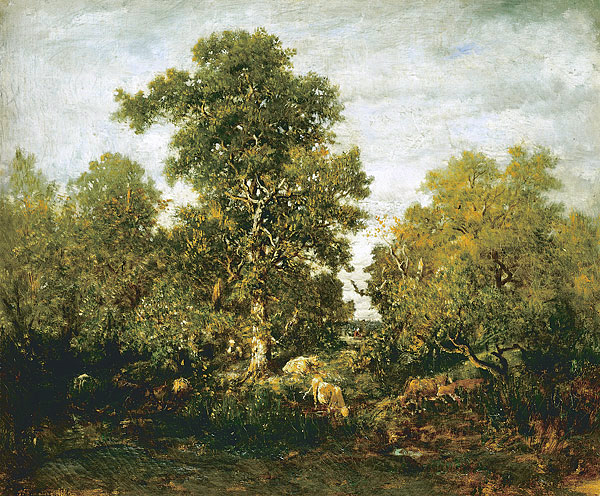
Fig. 1: Rousseau, The Pond (1850)
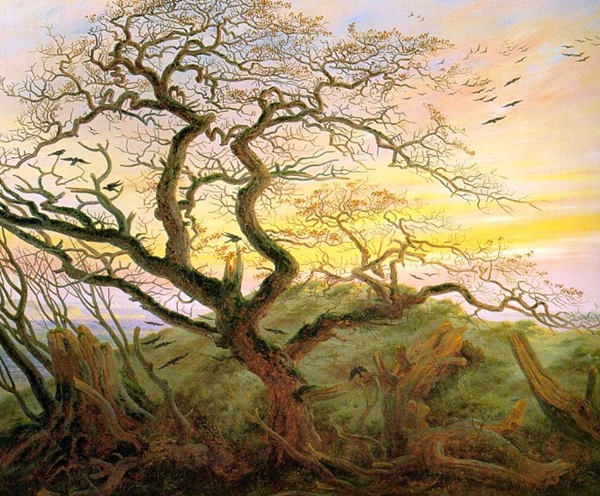
Fig. 2: Friedrich, The Tree of Crows (1822)
The plasticity of Parsifal’s inclined tree lies somewhere between the shaken tree of Friedrich’s ominous painting and the erect tree of Rousseau’s bucolic landscape. That tree works as a central axis that divides the frame in half, isolating Klingsor from Kundry. Even from this still frame it is natural to assume that, as a directorial choice, one of the two characters, at some point, will cross that line. Kundry is the most plausible candidate in that she is the one who evolves from her state of repentant sinner to the condition of relapsing offender.
The backdrop portrays the wilderness in which the action takes place. Monsalvat castle is located in a lonely mountain region; therefore, as indicated in Wagner’s stage directions, cliffs and rocks should be part of any realistic setting. Frames 5 and 6 reproduce the asperities of the Pyrenees: the former frame illustrates the beginning of Act III with Kundry, an aged Gurnemanz and a bearded Parsifal. Observe that, with respect to frames from Act I and II, the beard is a new element on Parsifal’s face. Evidently, the director wanted to show the spiritual transformation and enlightenment of the character across the second and third acts by adding to his physiognomy a feature that biblically stands for wisdom and knowledge. Frame No. 6 comes from the very beginning of the prologue to Act I. The frame could illustrate either Gurnemanz blessing Parsifal or Titurel blessing Amfortas (the age difference between the two suggests only those two possibilities). However, the latter seems more plausible: first, in the prologue Parsifal is introduced as a young boy with his mother and, if the kneeling figure is an older Parsifal, the overlapping of the same character at two different ages would be incongruous and confusing (above all for a 1907 spectator). Second, if the standing figure is Gurnemanz, the black headband he wears would contrast unreasonably with the band he wears later on (see Frame No. 5). Third, a "live" appearance of Titurel and Amfortas on the stage would create an explanatory continuity with the previous backdrop projection of one of the two celebrating the Grail rite, as already described.
A further juxtaposition of romantic and classical traits comes from the comparison of Frames 4 and 7. The former illustrates the very last moment of Act II: Klingsor’s castle is in ruins, its ruler dead (at the bottom left corner), and the whole environment expresses desolation and destruction. Parsifal and Kundry are framed by two bare trees, but the actual central element of the image is the re-conquered Spear.
The Spear is positioned directly on the bisecting axis that divides the angle formed by the imaginary converging lines with which the trees are aligned. In contrast, in Frame No. 7 (Parsifal renewing the ceremony of the Grail) the reading of the image proceeds in a bottom-up fashion along the parallel axes of the columns, with the central axis falling right on the line which conjoins the Grail, Parsifal and the dead body of Kundry. The space is recomposed in a solid, firm, symmetrical (except for the kneeling figure on the right) architecture, as a symbol of the faith to which the preceding adjectives apply.
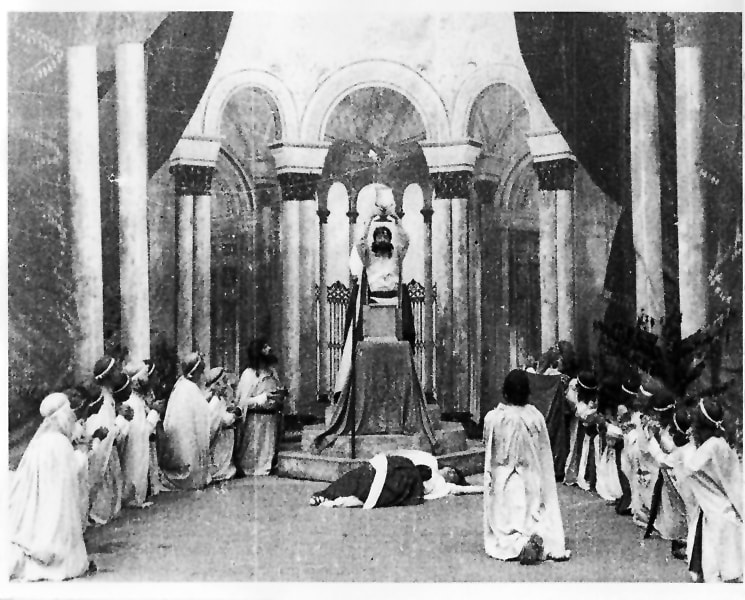
Frame No. 7
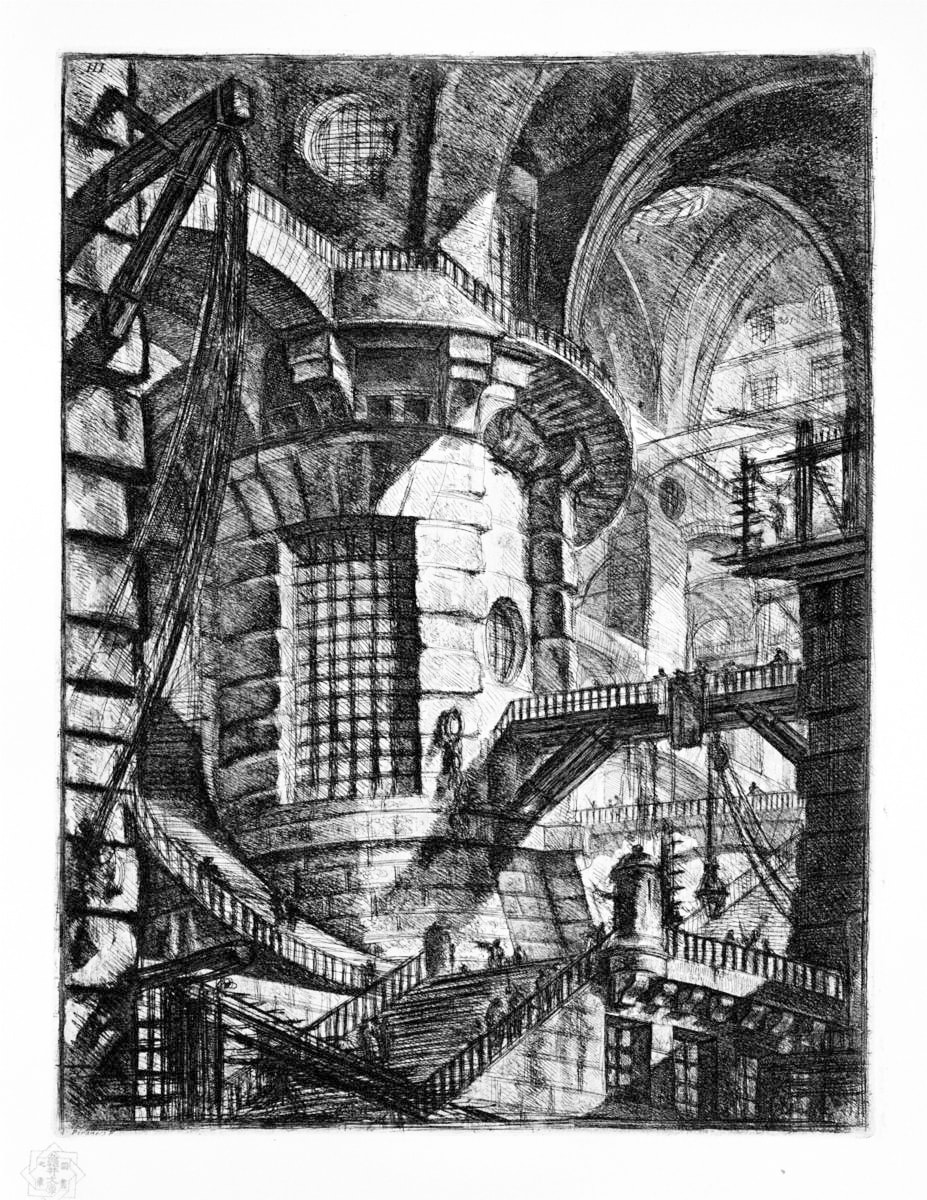
Fig. 3: Piranesi, The Round Tower, from Le Carceri, plate III, second ed. (1749-50)
Two more sequences, not shown in the frame examples, are part of the film: after the prologue in which Klingsor seeks admission to Montsalvat, Amfortas renews the rite in a scenario (shown in Frame No. 7) that is used later to accompany Parsifal exposing the Grail. The similarities of the mises-en-scène stress the visual and narrative symmetry implied in the Wagnerian dramatic plan and offer an interesting early case of cinematographic framing6. The second sequence, right after the previous one, shows the exterior of Klingsor’s castle; it is the same sequence in which Lucifer makes Kundry disappear. The scenario looks like a simplified version of Piranesi’s Le Carceri (Fig. 3) populated by gothic, Bosch-like elements: a skeleton on the right and gargoyles all around.
6 Framing, as a narrative technique described formalistically by Šklovskij in tales and novels, has been used for centuries. There are many classical examples (Boccaccio’s Decameron, Chaucer’s The Canterbury Tales, The Book of Sindibad, The Thousand and One Nights). In cinema, framing has been abundantly employed both as a narrative device (Robert Wiene’s Das Kabinett des Dr. Caligari , 1920 and Fritz Lang’s Der Müde Tod, 1921) or technical tool (King Vidor’s The Crowd, 1928 and Kenji Mizoguchi’s Ugetsu Monogatari, 1953), to cite only a few examples.
While Edison maintains a link with the ancestral and fanciful side of the romantic tradition, a heritage evidently still compelling for silent movie viewers, Syberberg grossly expands the iconographical repertoire to create a promiscuous combination of pictorial and dream-like images. Whereas Edison is conservative and intimately attached to the medieval imagery filtered through Germanic idealism, Syberberg, without denying Wagner’s specific cultural heritage, draws on a plentitude of scattered images from the entire history of Western art and culture. The latter’s artistic intention is obviously much more ambitious than the former’s. It tries, indeed, to represent the vastness of an overwhelming tradition (teutonic and, above all, European) by means of an overabundance of visual elements, so that the Western viewer can contemplate and, possibly, critically understand his or her own origins.
Syberberg’s Parsifal
An exposition of the complexity of Syberberg’s Parsifal could easily constitute a book (and actually has) not only because of the ideology that supports the movie and the enormous quantity of cultural references, but also because of the characteristics that Syberberg’s technique and imagery share with many masterpieces in the history of cinema. Syberberg addresses these factors in Parsifal: Notes sur un Film (an extensive and fully exhaustive description of the making of the film from the conceptual background to the final cut) and Syberbergs Filmbuch (which precedes the filming of Parsifal but, nevertheless, is a precious source on Syberberg’s filmmaking) [28; 29].
In Syberberg’s film, the deviation from Wagner’s aesthetics is particularly marked, mostly because the director applies to the representation some Brechtian modalities that are diametrically opposed to those employed by the composer. Commenting on this mixture of sources, Marcia Citron writes: What the film offers is a fascinating amalgam of Brecht and Wagner, itself an act of alienation and separation. Wagner’s aesthetics aims to abolish thinking in favor of a loss of self in the hypnotic music. Brecht advocates a pulling back and wants the spectator to objectify the action and reflect on it. Wagner abolishes distance, Brecht establishes distance. Parsifal does both at the same time [6, p. 155-156; see also 30, p. 199, 209].
Brecht was known to feel an intimate hate for Wagnerian aesthetics, namely, for a staging that treats the audience as a collective spectator whose sole function is to passively undergo the mighty dominance of the author (for more information on the subject see 4). Indeed, Syberberg both tells and at the same time disavows the Germanic myth (or at least the political use of that myth: le mythe comme souvenir, le myth comme mémoire, Syberberg writes [28, p. 11]) by means of a language that imposes on the audience a direct participation in the meaning of the film.7
7 Although, as Sergio Miceli suggests, the author’s declared aversion to the contemporary German leftist ideology and the presence of both Nietzsche’s and Marx’s masks in the scenario could infer a political statement: La piaga di Amfortas, alias Germania sinistrorsa, può guarire se toccata dalla lancia di Parsifal, alias ideologia destrorsa di Syberberg (Amfortas’s wound, alias leftist Germany, can heal only if touched by Parsifal’s spare, alias Syberberg’s right-wing ideology) [18, p. 872].
In the wake of meta-cinema, Syberberg does not hide the camera behind the fictional surface, but lets every cinematic component declare its artificial nature. For example, the cast sings in playback, namely on a pre-recorded soundtrack; the result is often an unmistakable discrepancy between the heard voice and the actors’ lip movements (in particular with the male Parsifal), no matter if Syberberg sees in synchronism the film’s vertus réelles (real virtues).
Jouer le chant proche de la musique, proche de la caméra avec toutes les possibilités qu’offrent le visage et les mouvements, et proche de la musique, c’est-à-dire en synchronie, sans faux-fuyant dans les maniérismes de l’ironie ou la provocation à la mode sous le nom d’expérience (play the singing close to the camera with all the possibilities offered by faces and gestures; play the singing close to the music, that is in synchrony with it, avoiding the safe refuge of the mannerisms of irony or the fashionable provocation that goes under the name of experience) [28, p. 18].
However, the variegated cast includes outstanding actors, such as Edith Clever (Kundry), who operates in the direction of a credible realistic acting, surely more realistic than on the opera stage (only Aage Haugland (Klingsor) and Robert Lloyd (Gurnemanz) are singers, everybody else is an actor, with the exception of Armin Jordan, the conductor, featured as Amfortas). But their attempts only go so far: as realistic as the actors aim to be, their gestures have to fit the pacing of music which impresses on them an unnatural and extremely stretched rhythm, so that they appear to move in slow-motion. Therefore, we wonder what path the director wishes to follow: omniscient realism or Brechtian alienation? Opting for the playback technique and the particular cast, Syberberg opens the way to very interesting stylistic possibilities: close-ups are not a problem anymore because actors and singers, freed from the difficulties of musical performance, will not have their faces "deformed" by the effort of singing, and, moreover, they can focus their attention on better acting.
Syberberg’s very keen theoretical observation with regard to close-ups deserves to be reported in its entirety: Or le film offre, comme jamais dans le théâtre des arts de représentation, la possibilité de voir le visage en gros plan. Le visage est celui du comédien et le son, donné par le chanteur, vient de la bande, de la technique. C’est le renversement de l’antique théâtre du masque, où la voix était celle de l’acteur présent et le masque dans l’appareillage technique (Nowadays cinema offers the possibility of watching a face’s close-up more than any other representational art. The face is the actor’s and the sound, produced by the singer, comes from the technology. It is the opposite of what happened in the ancient masked theater where the voice was the actor’s and the mask came from the technical equipment) [28, p. 46-47].
Playback allows Syberberg to use actors whose age realistically matches the age of the characters, whereas stagings of Wagner’s operas typically rely on forty-year-old lyric voices. But Syberberg adds a twist: in his Parsifal we hear an adult male voice coming from an underage boy and, later in the movie, from a twenty-year-old girl. This dramatic device, which dissociates Parsifal into male and female personae, is particularly striking because it uses the imagery of androgyny to symbolize purity and innocence.8
8 Here, it is hard not to think of the character of Tadzio as described in Mann’s Death in Venice and represented in Visconti’s film with the same name. For an accurate recognition of the androgynous nature of Parsifal see Citron [6, p. 148-154] and, above all, Nattiez [21, p. 290-291]. For a psychoanalytical reading of Parsifal’s double nature in Syberberg’s film see Tambling [30, p. 203-206].
The entire scenario was recreated in a studio and the theatrical location was enhanced by the artificial lights and non-realistic possibilities of front-screen projection9, the same technique Syberberg used extensively as early as 1977 in his Hitler, a Film from Germany (released in the USA as Our Hitler, a Film from Germany, a title change suggested by Francis Ford Coppola).
9 Front projection, which came into use in the 1960s, projects the setting onto a two-way mirror, angled to throw the image onto a highly reflective screen. The camera photographs the actors against the screen by shooting through the mirror. The result of front projection can be clearly seen in the "Dawn of Man" sequence in Kubrick’s 2001: A Space Odyssey, the first film to use front projection significantly. Because of the sharp focus of the projected footage, front projection blends foreground and background planes fairly smoothly, whereas rear projection does not create very convincing depth cues. Foreground and background tend to look starkly separate, partly because of the absence of cast shadows from foreground to background, partly because all background planes tend to seem equally diffuse. Nevertheless, rear projection is still widely used, while front-screen projection, probably because it is much less realistic, has been confined to experimental productions.
Syberberg made thousands of slides to represent the Germany’s immense cultural and historical inheritance. As Citron states, such a cumbersome variety of pictures also offers a dialectical counterpart to the other components of the representation: these changeable backgrounds form a flexible counter-rhythm to the musical drama and to the static camera and theatrical setting [6, p. 145].
Derrick Everett tried to summarize the encyclopedic imagery with which Syberberg’s Parsifal nearly overwhelms the viewer: The studio set is dominated by a huge replica of Wagner’s death mask, becoming a mountain on which much of the action is staged, being Klingsor’s tower, the flowery meadow and finally parting in two to reveal (Syberberg’s vision of) the Grail. The density of allusion in the film is enormous and too much to comprehend in a single viewing: Caspar David Friedrich [as in Edison’s Parsifal], Ingres, Goya, Dürer, Titian, Caravaggio and Bramante all figure in the imagery; the allegorical statues of the Synagogue and Faith on Strasbourg Cathedral are evoked; Amfortas sits on Charlemagne’s throne from the cathedral at Aachen; Titurel lies in the crypt of Saint-Denis; scenes from various Bayreuth productions of Parsifal and the Ring appear; the 1882 production of the former is recreated in puppet form during the prelude, with both costumes and faces modelled from photographs; a casement in the room in the Palazzo Vendramin, where Wagner died, is used as a backdrop; heads of Aeschylus, King Ludwig, Nietzsche, Marx and Wagner himself lies at the foot of Klingsor’s throne; Mathilde Wesendonk and Judith Gautier are glimpsed among the flower maidens; the approach to the hall of the Grail is down a flag-lined corridor – a procession, backward in time, through the history of Germany into a world of myth; the destruction of Germany is evoked at the beginning with postcards of the ruins, and we see various puppets of Wagner, including of André Gill’s caricature of Wagner hammering at a human ear [9].
The interlacing of references and self-references is of astonishing complexity. The beginning of the film and the end of each act are framed with the image of Kundry’s arms and hair wrapping a sort of glass shrine. At the end of the movie, the camera zooms out to show that in the shrine there is a tiny reproduction of the Bayreuth theater.10 Moreover, the face of Kundry with long red curly hair (Fig. 5) has an unmistakable precedent in the 1851 Pre-Raphaelite painting of The Bridesmaid by John Millais (Fig. 4):
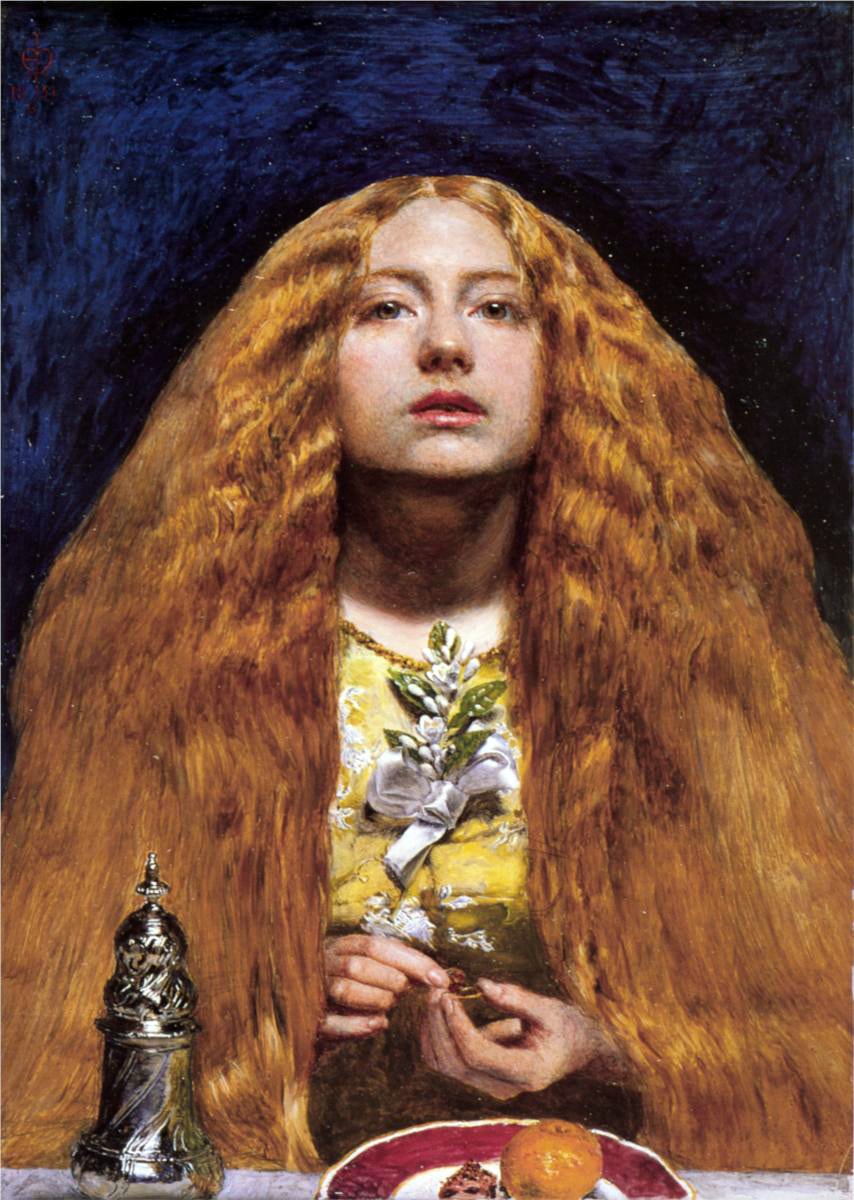
Fig. 4: Millais, The Bridesmaid (1851)
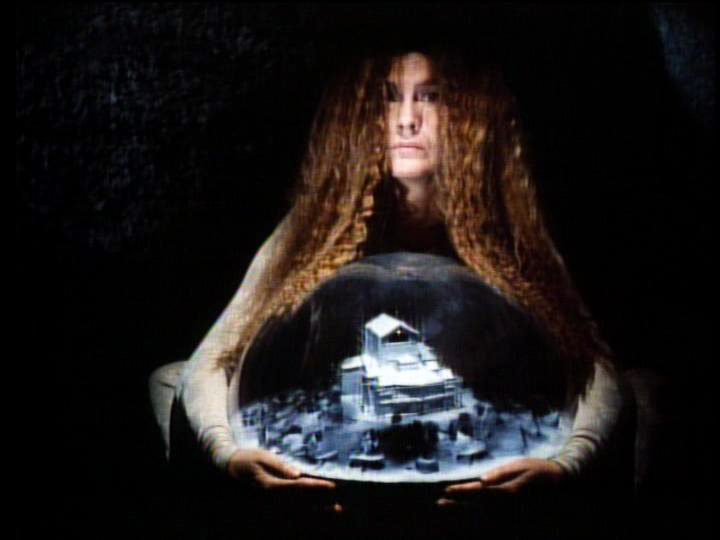
Fig. 5: Syberberg's Parsifal (1982), End of Act III
10 A similar image — a glass paper weight with a snow scene in it — introduces and concludes each of the four parts of Hitler: It reminds us of the glass globe in Citizen Kane, as Betsy Erkkila noted [8, p. 216-217].
This painting and its painter are not named in the series of iconographic references listed by Syberberg. On the other hand, the resemblance is too striking to be a coincidence. He cites Dürer, Ingres, Goya, Füssli, Blake, Van Eyck and Friedrich (remembered here for his Crucifix dans la Montagne, Fig. 6), which brings us back to Edison11:
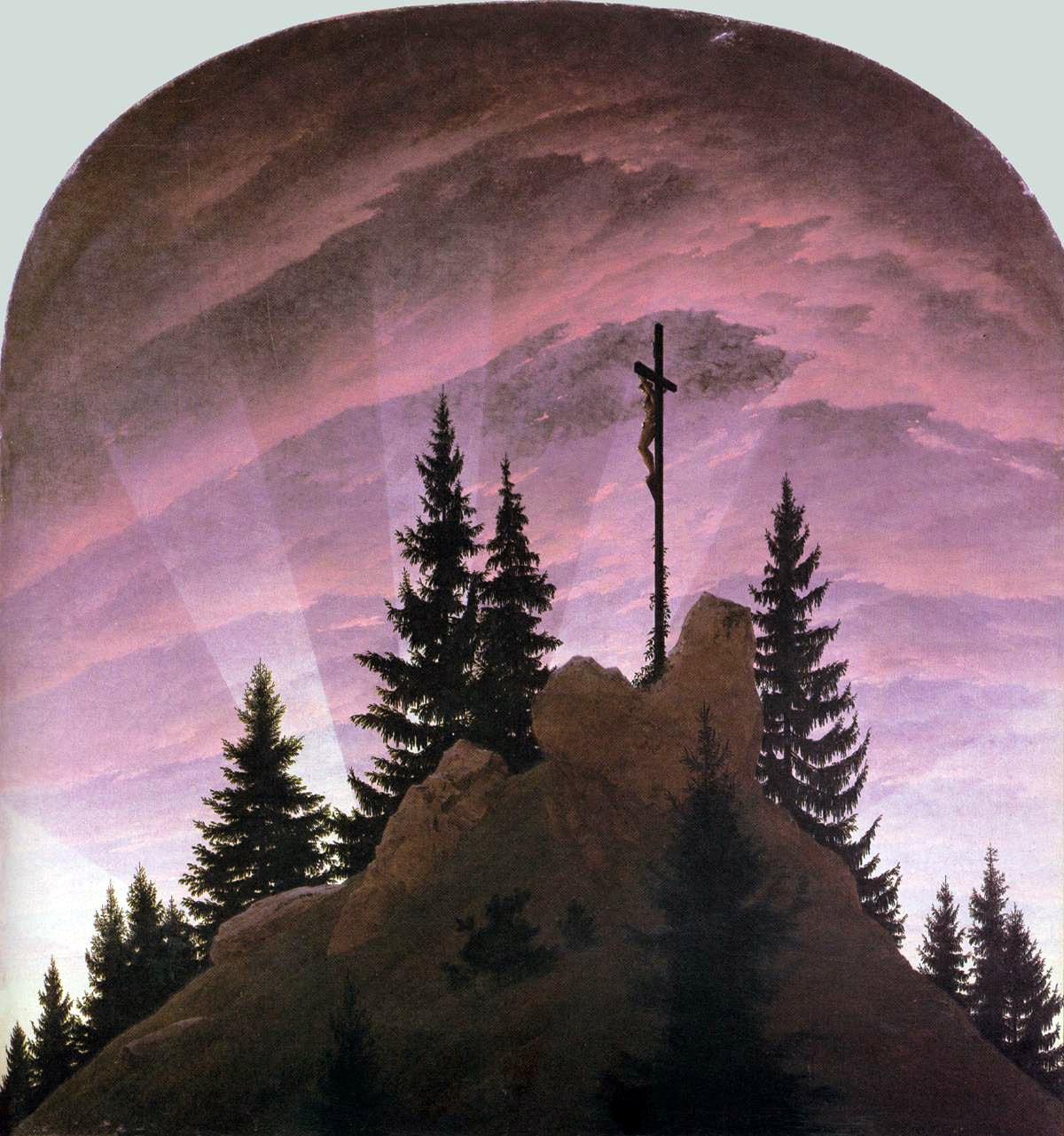
Fig. 6: Friedrich, Cross in the Mountains (1808)
11 Cette tête de Wagner se transforme en projection d’un matin de Caspar David Friedrich, le Crucifix dans la Montagne (Retable de Tetschen) en Bohème, la Bohème où se sont rencontrés les histoires mythiques et Richard Wagner, qui y fut transporté avec sa mère après sa naissance (This Wagner’s head transforms into the projection of a picture by Caspar David Friedrich, the Crucifix dans la Montagne (Retable de Tetschen) in Bohemia, the region where Wagner went with his mother after his birth and where he encountered the mythical tales the composer used in his later works) [28, p. 59].
It is evidently the visionary-fantastic imagery of the shadowy area straddling two centuries (eighteenth and nineteenth) and two contrasting sensitivities (Enlightenment and Romanticism) that Syberberg privileges in order to convey the tradition that informed Wagner’s cultural background. That quite solid group of artists (the only one still rooted in Classicism being Ingres) finds resonance in the past and in the future through references to Bosch (as, again, in Edison), Mantegna and Méliès (with regard to the starry sky against which Kundry comes in).
The entire movie is self-referential: Armin Jordan, the conductor of the opera, appears in the role of Amfortas, but also in the role of a musician when the image of himself conducting the opera is projected for a few seconds on the background (Act III). Wagner is constantly present, having the function of demystifying "the artistic process" and alienating "the spectator from the illusionism of the theater", as Joe has argued [13, p. 11]. It is clearly shown at the beginning and at the end of the movie that the scenario is a huge reproduction of Wagner’s face profile. By making the actors literally emerge from [it], Syberberg’s film visually reveals that the lives of the on-stage characters are not reality but figments of the composer’s imagination [ibid.].
The characters live and walk in the folds of Wagner’s brain as if these folds were corridors, the bottom of rocky cliffs or a Second World War trench, especially in the backward-in-time procession that Everett mentions at the end of the above quotation. Syberberg describes these journeys as "la quête du Graal à travers la culture européenne" (The quest for the Grail throughout European culture) [28, p. 9] so that histoire individuelle [Wagner’s] et histoire de la culture [Europe’s] pouvaient-elles être disposées de manière à former ce cosmos d’images de la musique, tel que le film l’a développé à sa manière (Personal history [Wagner’s] and history of culture [Europe’s] can be arranged to shape this world of musical images, which cinema developed in its own way) [28, p. 20].
The claustrophobic dimension of a scenery made of narrow places and fog is enhanced by the labyrinthine journey of the camera, which follows Parsifal in the adventure/discovery of his creator’s phantasmagorical world. The space is so planned that the spectator immediately loses any point of reference and is compelled, by his/her active participation in the movie, to mentally recreate a possible and livable environment (Robert Bresson is without a doubt the direct source of such a treatment of space. He manipulated the perception of the audience in more than one movie, among which I recall here Lancelot du Lac, 1974 for its consonance with the subject of Parsifal). Syberberg is faithful to the many details of the scene but reluctant to show the background suggested in Wagner’s scenery description. The director willingly encloses a space that would otherwise be suitable for broad perspectives of castles and mountains. The result, clearly intentional, is a limited traversable area. In general, only a few people move on the set: Parsifal, Gurnemanz, and Kundry, Amfortas being carried on a litter. Everybody else, unless involved in one of the many processions, maintains a fixed position and becomes part of a living painting that the camera explores with a slow choreographic movement back and forth on significant details or characters (a filmic strategy that has been deeply investigated by the art historian Carlo Ludovico Ragghianti in his Critofilms [from criticism + film], twenty-one experimental short movies dedicated to a revolutionary way of delving into the secrets of some masterworks of figurative art). This is how Syberberg justifies his long shots (up to nine minutes): la genèse des longs plans de ce film comme marque extérieure d’un style est parente de ses avantages économique… j’ai réfléchi à la manière de rassembler ce qui était à l’origine plusieurs idées de plans en un seul. Ainsi sont nées de longues séquences à caméra mobile (The genesis of the long shots of this film as a feature of a style is related to its economic advantages… I reflected on the way to assemble what at the origin were many ideas of shots into a single shot. Thus, long sequences with mobile camera were born) [28, p. 20-21].
Nonetheless, Syberberg affirms that, since shots are so dilated as to cover entire sequences, the camera becomes the real and sole medium that provides the continuity that “endless melody” can only loosely convey. This is the stylistic principle of the movie, as the author utters categorically: the seemingly infinite movement of the characters, gazes, camera, lights, etc. In the end, the camera, namely the device without which cinema could not exist, takes on the role of dance, music and poetry in that its penetrating close-ups on the characters make legible, somehow, their inner emotional states. This is how I would describe the principle of Gesamtkunstwerk in Syberberg’s film. Yet Syberberg has a much more orthodox way of presenting the concept of the total work of art: "L’œuvre d’art totale"… Les différents éléments de structure qui déterminent ailleurs les films autrement organisés, ou plutôt montés, devaient être cette fois ménagés de manière à faire naître une unité qui se laisse difficilement dissocier ("The total work of art"… The different structural elements that determine the organization of the movie, or rather the editing of it, must be handled this time in order to let a hardly dissociable unity to emerge) [28, p. 11]. This unification has the characteristic of being synergetic in a way not explicitly admitted by Wagner, but sincerely exposed by Syberberg: Une imagination du type de la mienne n’est pas de nature inventive… Sa particularité réside dans la faculté de combinaison de ce qu’elle trouve comme déja donné de manière à éveiller en nous un troisième terme, optique-acoustique, peut-être aussi olfactif, tactile, gustatif (My imagination is not inventive… its peculiarity resides in its ability of combining what already exists. Its task is to awake a third sense, optical-acoustic, perhaps also olfactory, tactile, gustative) [28, p. 40].
Eventually, Syberberg reaches a sort of visionary apotheosis when, at the end of his book, he states that the technical means and the sheer nature of cinema contain an intrinsic image/sound joining: C’est ainsi qu’est réuni à la fin ce qui était séparé par notre histoire. De même qu’Amfortas et Kundry s’unissent dans le mort de ce film, comme les deux sexes de Parsifal s’unissent dans l’enlacement paradisiaque de cette tête [Wagner’s], comme la loi ancienne et la loi nouvelle parviennent enfin à s’épouser et par-delà tous les abîmes de notre division, de notre dispersion en éléments et de notre nature, nous parvenons grâce à la technique de notre temps à réunir la voix idéale et le corps idéale, les images et les sons (This is the way in which what was separated during the story gets summoned at the very end. As Amfortas and Kundry join in the death of this movie, as the two genders of Parsifal join in the paradisiacal enlacement of this head [Wagner’s], as the ancient and the new law, and the gaps of our divisions, our dispersions and our nature eventually unite themselves, so, thanks to the technology of our time, we can unify the ideal voice and the ideal body, sounds and images) [28, p. 208-209].
I am very skeptical regarding whether the author attains the form of Gesamtkunstwerk he describes. Indeed, I will soon suggest a contrary point of view that I have hitherto only hinted at. It seems to me that by means of its own immanent artificiality, the "technique de notre temps" Syberberg mentions emphasizes even more the division between auditory and visual realms. As Ulrike Sieglohr writes of Schroeter’s films, The emphasis on non-harmonization between image and sound…conveys…painfully nostalgic yearnings that can find no fulfillment, thereby death becomes a kind of liberation [27, p. 211]. Sieghlor’s comment about Schroeter’s cinematography may be conveniently applied to Syberberg’s aesthetics as a further trait in the overall composition of New German Cinema. Another scholar, Norma Darr, seems to agree with this deconstructive reading of Syberberg’s Parsifal when she traces a parallel between the movie and a performance-installation of Parsifal at the Festspielhaus Hellerau in Dresden (1995): When the prelude ends, the Hellerau Parsifal proceeds to disrupt the unity of Wagner’s score and text, emphasizing instead the iconography and selected fragments of Wagner’s composition and forming new relationships between sound and spectacle. Like Hans-Jürgen Syberberg’s film of Parsifal, it emphasizes that the action and its history are based on what is now a ruin. Syberberg opens his film with the camera slowly panning across photos and postcards of ancient structures, some relatively intact, others in ruins (as the Hellerau space is after decades of misuse) [7, p. 633]. (In the article the author also explores the "iconography and cultural heritage of Parsifal as visibly employed — and contested — in the performance-installation").
The camera is not the only "figure" that moves around the set. The theme of the wandering subject is conveyed either by the camera or the characters, or by both of them at the same time, according to the dramatic situation. As Everett writes, a recurring element of this film is movement in procession. Indeed, processions of knights are required by the score and Syberberg makes the most of these. Syberberg introduces other processions too, not required by the stage direction. Such as the pages with the dead swan, or the group that searches for and brings back the Grail, an enormous rock in the shape of a platonic solid. Where a stage production of Parsifal would be static, Syberberg introduces purposeful movement, with the camera also moving with the procession. In the transition scene of the first act, we follow Parsifal and Gurnemanz through a maze: moving in space, they seem to move backwards in time from the present, passing through the Nazi era on the way. In the transition scene of the third act, the path to the Grail Temple seems to pass through the sky [9].
Everett gives an accurate description of some of the processions in Syberberg’s Parsifal, yet it seems naive to assert that “a stage production of Parsifal would be static.” First of all, stage directions are traditionally ephemeral indications that each director, as interpreter of the text, can strictly follow or disregard entirely. Therefore, a very dynamic Parsifal is certainly a possibility. Secondly, I would claim precisely the opposite regarding Syberberg’s film: Syberberg accentuates stasis rather than the dynamism of Wagner’s opera. For instance, in Edison’s movie the Flower Maidens flatter Parsifal by dancing sensually around him, while in Syberberg they are no more than living statues that Parsifal meets during his travels. Even the body language of the actors is confined to strictly necessary gestures, perhaps because a constrained expressivity solves in part the problem of the above-mentioned extremely stretched rhythm of the music. Undoubtedly the effect thus obtained and exploited by Syberberg is a hieratic, superhuman performance that perfectly conveys the holiness and mysticism of the subject.
To conclude, let us turn to the duration of Syberberg’s movies: Hitler and Parsifal respectively last seven hours and four hours and fifteen minutes, two spans of time of Wagnerian size but not very appropriate for cinematographic commercial distribution. Certainly Parsifal owes its length to the original musical work, but let us not forget that nothing prohibits the director from shortening the performance to a more reasonable duration. Even Bergman, in his Tröllflojten | The Magic Flute (1974), made some cuts that reduced the duration of the opera to a little more than two hours. It is more likely that Syberberg exploits the epic length of his films to contest and to practically impede any commercial use of his art. Such a rejection of the economic system of the cinema industry recalls the pristine isolation Parsifal enjoyed during its first thirty years at Bayreuth. However, while Wagner’s refusal to participate in the opera market was dictated by his quest for better spiritual and practical conditions for the performance of his last work, for Syberberg it was matter of politically challenging a system that imposes strict aesthetical rules. Whereas Wagner did not necessarily deprive Parsifal from being "art for the people", at least in a limited sense, Syberberg could be suspected of an intellectual operation that along with rejecting the cinema industry also discards a significant portion of its potential audience.
My concern in this paper has been the readings that two authors from different times, places, and ideologies gave to the same subject: Wagner’s Parsifal. The iconography of Edison’s and Syberberg’s films, besides presenting historically contextualized imagery tied to centuries-old popular beliefs, also perpetuates, in very different ways, the "epiphanic" function of art as espoused by Wagner: Art can show that the symbols which religions would have us believe literally true are actually figurative. Art can idealize those symbols, and so reveal the profound truths they contain (Quoted in John J. O’Connor [24, p. 20]. The author does not mention the source of his quotation).
In pursuing this Wagnerian project, the films by Edison and Syberberg share similar narrative choices (framing techniques and the staging of the prologue) and, most relevantly, a basic faithfulness to Wagner’s stage directions. However, in two different and perhaps contrary ways, they negate the principles of the "total work of art", even though Susan Sontag named Syberberg the legitimate heir and the ultimate fulfillment of the Wagnerian ideal of Gesamtkunstwerk [13, p. 3]. Edison does it in a more unconscious way, right at the moment when he minimizes the importance of music by mentioning an available and optional score at the very end of his advertisement. Music is apparently the least of his worries, while the extra-filmic intellectual aspect (the lecture) and the religious sentiment of the work assume roles of paramount relevance (not least for reasons of marketing). Syberberg, unlike Edison, intentionally responds to the impossibility of a "total work of art" with a representation that disjoins the longed-for unity of sound and image as envisioned by Wagner. The basis of Wagner’s aesthetics was his attempt to bend myth to a local and temporal ethical function valid only for Germanic people. Syberberg does not completely deny the "Germanicity"of Parsifal, but, as in previous works, he tries to efface its national connotations in favor of a broad human message. This explains why Francis Ford Coppola, aware of the universality of Syberberg’s intentions and with the director’s approval, felt it natural to rename Hitler as Our Hitler. Yet the fragmentation of the compound cinematic language into its separate units of sound and image leaves a bitter flavor in one’s mouth.
Syberberg does not talk in a postmodern way about his films, but he sounds very self-confident when he presents the aesthetic intentions fueling the practical realization of his works. Citron interprets Syberberg’s prose as the director’s conscious imitation of Wagner’s style, but at the same time she interprets Syberberg’s writing as a rhetorical act of criticism that aims to expose Wagner’s foibles… [6, p. 147-148]. This latter reading is more convincing because it multiplies the interpretative possibilities and characterizes imitation, which is never neutral except in automata, as an ethical act. Therefore, in the end, Syberberg is putting forward a pessimistic criticism of opera in film and, more broadly, of the sound/image relationship. Further, by announcing the impossibility of a harmonic fusion of the arts is he confessing the impossibility of cinema? Is he metaphorically describing that irreparable social dissolution from which Wagner desperately struggled to save his world? If the camera is the "secret" unifying agent, is it still trusted to faithfully record that dissolution? And, finally, the expected, perpetual, ontological question: should we believe what we see and what someone wants us to see — in this case, the "unified" representation of dissolution?
Those who direct or film Parsifal in the theater do not have to deal with such embarrassing dilemmas. Their aesthetic options are in any case confined within the burdens imposed by live performance: time and spatial continuity, inviolable separation between the audience and stage action, and limited camera movements. The "total work of art" is safeguarded by the lack of technological interventions, because in the end it seems that the more the original conditions of Wagnerian staging are preserved the more the Gesamtkunstwerk, although utopian, finds its own realization. I am not proposing here any kind of moral or aesthetic judgment; I simply state that in my opinion, as soon as we increase the complexity of the representational apparatus we obtain something that goes beyond the idea of Gesamtkunstwerk and transcends the principles on which Wagner’s theoretical framework was based. Therefore, the provocative irony set up in the introduction to this paper refers to the impossibility of improving the concept of "total work of art" without compromising its own nature. The fusion of the arts cannot be measured only in terms of advanced technological syncretism; it needs to be understood as an historical contingency that was born and died with the person who created it: Wagner.
References
- Altman, Rick. Silent Film Sound. N. Y.: Columbia University Press, 2004. 462 p.
- Bazin, André. Qu’est-ce que le cinéma? P.: Editions du Cerf, 1958. 145 p.
- Benjamin, Walter. “The Work of Art in the Age of Mechanical Reproduction”. In Illuminations / ed. by Hannah Arendt, transl. by Harry Zohn. N. Y.: Schocken Books, 1969, pp. 155-200.
- Brown, Hilda M. Leitmotiv and Drama: Wagner, Brecht, and the Limits of 'Epic' Theatre. N. Y.: Oxford University Press, 1991. 217 p.
- Chion, Michel. Audio-Vision: Sound on Screen / ed. and transl. by Claudia Gorbman, foreword by Walter Murch. N. Y.: Columbia University Press, 1994. 239 p.
- Citron, Marcia J. Opera on Screen. New Haven (CT) and L.: Yale University Press, 2000. 295 p.
- Darr, Norma M. “Reading the Body and Blood of Parsifal: A Performance at Hellerau”. In The Musical Quarterly, 1996, vol. 80, no. 4, pp. 629-647.
- Erkkila, Betsy. “Hans-Jürgen Syberberg: An Interview”. In Literature Film Quarterly, 1982, vol. 10, no. 4, pp. 206-218.
- Everett, Derrick. “Parsifal: A Film by Hans Jürgen Syberberg”. In Monsalvat.no, 2011, August 13. URL: http://www.monsalvat.no/sybrbrg.htm (accessed 19.03.2013).
- Finck, Henry T. My Adventures in the golden Age of Music. N. Y.: Funk Wagnalls Company, 1926. 462 p.
- Hayward, Susan. Cinema Studies. The Key Concepts. L. and N. Y.: Routledge, 2000. 528 p.
- Huckvale, David. “The Composing Machine: Wagner and Popular Culture”. In A Night in at the Opera: Media Representations of Opera / ed. by Jeremy Tambling. L.: John Libbey, 1994, pp. 270-283.
- Joengwon, Joe. “Hans-Jürgen Syberberg’s Parsifal: The Staging of Dissonance in the Fusion of Opera and Film”. In Music Research Forum, 1998, no. 13, pp. 1-20.
- Kolodin, Irving. The Story of the Metropolitan House, 1883-1950, a Candid History. N. Y.: Knopf, 1953. 607 p.
- Kracauer, Siegfried. Theory of Film. The Redemption of Physical Reality. N. Y.: Oxford University Press, 1960. 364 p.
- Mayer, Martin. The MET. One Hundred Years of Grand Opera. N. Y.: Simon and Schuster, 1983. 368 p.
- McGowan, Todd and Kunkle, Sheila (eds.). Lacan and Contemporary Film. N. Y.: Other Press, 2004. 246 p.
- Miceli, Sergio. Musica per Film. Storia, Estetica-Analisi, Tipologie. Milano: Ricordi / LIM, 2009. 1025 p.
- Millington, Barry. S. v. “Parsifal”. In New Grove Dictionary of Opera / ed. by Stanley Sadie. L.: Macmillan Press, 1992, vol. 3, p. 890.
- Münsterberg, Hugo. The Film: A Psychological Study. The Silent Photoplay in 1916. N. Y.: Dover Publications, 1970. 100 p.
- Nattiez, Jean-Jacques. Wagner Androgyne: A Study in Interpretation. Princeton: Princeton University Press, 1993. 359 p.
- New Edison Films. In Motion Picture World, 1907, December, 7, p. 655. (URL: http://archive.org/stream/MPW01-1907-12/MPW01-1907-12_djvu.txt).
- New York Times, 1906, September 9, p. 29.
- O’Connor, John. “Review/Television; The Met Production of Wagner’s ‘Parsifal’ ”. In New York Times, 1993, April 7. URL: http://www.nytimes.com/1993/04/07/news/review-television-the-met-production-of-wagner-s-parsifal.html?scp=1&sq=&st=nyt (accessed 19.03.2013).
- Paulin, Scott D. “Richard Wagner and the Fantasy of Cinematic Unity. The Idea of the Gesamtkunstwerk in the History and Theory of Film Music”. In Music and Cinema / ed. by James Buhler, Caryl Flinn and David Neumeyer. Hanover (NH): University Press of New England, 2000, pp. 58-84.
- Schoenberg, Arnold. Style and Idea / ed. by Leonard Stein, transl. by Leo Black. Berkeley: University of California Press, 1984. 559 p.
- Sieglhor, Ulrike. “Excess and Yearning: The Operatic Work of Schroeter’s Cinema”. In A Night in at the Opera / ed. by Jeremy Tambling. L.: John Libbey, 1994, pp. 195-217.
- Syberberg, Hans-Jürgen. Parsifal: Notes sur un film. P.: Gallimard, Cahiers du Cinéma, 1982. 250 p.
- Syberberg, Hans-Jürgen. Syberbergs Filmbuch. München: Nymphenburger Verlagshandlung, 1976. 314 S.
- Tambling, Jeremy. Opera, Ideology and Film. Manchester: Manchester University Press, 1987. 223 p.
UDC 7.046.2 + 7.094
Bibliographic reference:
